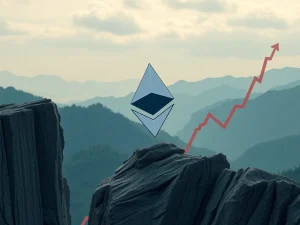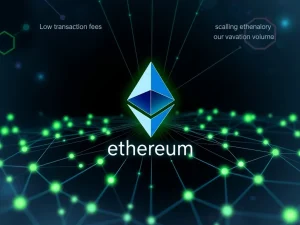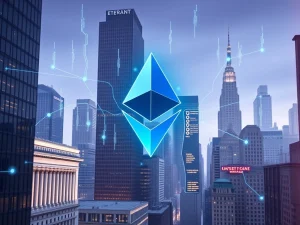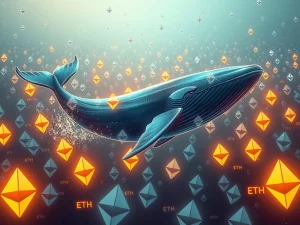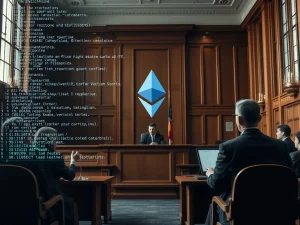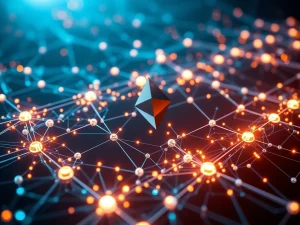Ethereum RWA Tokenization: Unveiling the Revolutionary ERC-7943 Standard

The burgeoning sector of **real-world assets** (RWAs) on the blockchain is experiencing unprecedented growth. However, this expansion brings significant challenges, particularly **tokenization fragmentation** and complex compliance requirements. A new solution has emerged to address these critical issues: the **ERC-7943 standard**. This innovative Ethereum Improvement Proposal (EIP) aims to establish a universal baseline for RWA tokenization, promising a more streamlined and compliant future for digital assets.
Unpacking the Revolutionary ERC-7943 Standard
A coalition of Web3 and fintech companies recently introduced ERC-7943, an Ethereum token standard meticulously designed to simplify **blockchain compliance** and reduce fragmentation within the rapidly expanding RWA sector. Dario Lo Buglio, co-founder of Brickken and the primary author of EIP-7943, explains its core purpose. He notes the standard creates a minimal, modular interface. Furthermore, it works seamlessly across Ethereum Layer-2s and other Ethereum Virtual Machine (EVM) chains. Significantly, it remains agnostic to specific implementations and vendor-specific infrastructure. This flexibility ensures it can integrate into any existing setup without vendor lock-in.
Lo Buglio describes ERC-7943 as a “universal layer” positioned above any token type. This crucial design allows developers and institutions to avoid the complexities of using wrappers and custom bridges. Integrating tokenized assets into various applications becomes much simpler. The standard’s primary goal is to solve industry fragmentation by providing a single, standardized set of functions for compliance. This approach offers a unified framework, fostering greater interoperability and efficiency across the ecosystem.
Addressing Blockchain Compliance Challenges
One of the most significant hurdles in RWA tokenization involves meeting stringent regulatory and **blockchain compliance** requirements. Traditional financial institutions demand programmable controls that perfectly align with their existing compliance frameworks. Conversely, developers often face the arduous task of rewriting custom logic for every new RWA token. This disparity creates considerable friction and slows adoption. ERC-7943 directly confronts this challenge.
The standard defines a common foundation for compliance functions. This means institutions can implement their desired controls with standardized tools. Developers no longer need to build bespoke solutions for each asset. Lo Buglio emphasized this point, stating, “Financial institutions want programmable controls that match their compliance frameworks. Developers, on the other hand, are stuck rewriting custom logic for every RWA token. We needed a common foundation.” This universal approach ensures that compliance becomes an inherent feature, not an afterthought, for all tokenized **real-world assets**.
The Surge in Ethereum RWA Tokenization
The introduction of ERC-7943 comes at a pivotal moment for **Ethereum RWA tokenization**. Institutional interest in RWAs has reached a “perfect storm” level, according to Lo Buglio. Data from RWA tracker RWA.xyz powerfully illustrates this trend. The total value of tokenized RWAs on-chain has surged to $28.44 billion, marking an increase of nearly 6% in the last 30 days. Moreover, stablecoins, often considered a gateway to RWAs, have seen their total value and total asset holders rise by almost 7% and 9% respectively.
This rapid growth signifies that institutions are adopting RWAs at an accelerating pace. Issuers are actively competing for market share, highlighting the urgent need for robust and standardized infrastructure. The demand for a new token standard that caters to both developers and financial institutions is clear. ERC-7943 seeks to fulfill this demand by offering a scalable and compliant framework for this burgeoning market. It paves the way for wider institutional participation in the digital asset space.
Overcoming Tokenization Fragmentation
The problem of **tokenization fragmentation** has plagued the RWA sector. Without a unified standard, different projects and protocols develop their own unique methods for tokenizing assets. This creates silos, hinders interoperability, and increases development costs. Each custom solution requires specific integrations, making the ecosystem cumbersome and inefficient. ERC-7943 directly addresses this by offering a single, standardized set of functions.
By providing a common interface, the standard allows various systems to communicate and interact seamlessly. This dramatically reduces the need for complex custom bridges or wrappers, which often introduce security risks and operational overhead. Lo Buglio firmly believes this standard will unify the industry. It establishes a baseline that ensures consistency and predictability across the RWA landscape. This collaborative effort aims to unlock the full potential of tokenized **real-world assets**.
A Closer Look at Previous Tokenization Solutions
Earlier attempts have aimed to standardize RWA tokenization on Ethereum. Two notable examples include ERC-1400 and ERC-3643. Each of these standards introduced valuable concepts, yet they also presented specific limitations that ERC-7943 seeks to overcome.
- ERC-1400: This standard introduced a hybrid model. It blended features of fungible and non-fungible tokens (NFTs). Furthermore, it incorporated built-in compliance tools, offering a foundational approach to regulated assets. Lo Buglio noted that ERC-1400 focuses on separating logic from storage, a key architectural principle.
- ERC-3643: This standard specifically targeted regulated assets like securities. It integrated on-chain identity and permission layers. These features were crucial for enforcing Know Your Customer (KYC) and Anti-Money Laundering (AML) requirements. While powerful for securities, Lo Buglio pointed out that ERC-3643 is tightly coupled to its own identity and permissioning stack, limiting its broader applicability.
ERC-7943 differentiates itself significantly from these predecessors. Lo Buglio explains its unique advantage: it is a minimal, implementation-agnostic interface. “EIP-7943 defines only what must exist — not how it’s built — so any project or protocol can slot it into their stack without friction,” he stated. This flexibility is key to widespread adoption. It ensures that the standard can adapt to diverse needs and existing infrastructures, making it a truly universal **tokenization solution** for **real-world assets**.
The Collaborative Force Behind ERC-7943
The development and promotion of ERC-7943 are not the work of a single entity. A robust coalition of prominent Web3 and fintech firms stands behind this initiative. This collaborative effort underscores the industry’s collective commitment to solving existing challenges. The backing from diverse companies highlights the widespread recognition of the need for a unified standard.
Key members of this influential coalition include:
- Bit2Me
- Brickken (co-founded by Dario Lo Buglio)
- Compellio
- Dekalabs
- DigiShares
- Hacken
- Forte Protocol
- FullyTokenized
- RealEstate.Exchange
- Stobox
- Zoth
This broad support network demonstrates a shared vision for a more interoperable and compliant future for **Ethereum RWA tokenization**. The collective expertise of these firms strengthens the standard’s potential for widespread adoption and success. Their involvement ensures the standard addresses practical industry needs.
The Road Ahead for the ERC-7943 Standard
The **ERC-7943 standard** has entered a critical phase in the Ethereum Improvement Proposal (EIP) process: the review stage. This period is crucial for gathering feedback and making necessary refinements. Dario Lo Buglio confirmed that the EIP is currently undergoing thorough review. It has already received valuable input from compliance professionals and other authors of token standards. This feedback mechanism ensures the standard is robust, comprehensive, and addresses real-world use cases.
The review stage allows for a collaborative refinement process. It helps to ensure that the final standard is widely accepted and effective. The incorporation of diverse perspectives will undoubtedly strengthen ERC-7943. Ultimately, this will solidify its position as a foundational element for **real-world assets** on the blockchain. The successful implementation of this standard promises to unlock new opportunities for innovation and growth in the digital asset landscape.
The emergence of the ERC-7943 standard marks a significant step forward for **Ethereum RWA tokenization**. By offering a minimal, modular, and implementation-agnostic framework, it directly tackles the pervasive issues of **tokenization fragmentation** and complex **blockchain compliance**. This standard provides a much-needed common foundation for developers and institutions alike. As the EIP progresses through its review stage, it holds the potential to revolutionize how **real-world assets** are brought on-chain, paving the way for a more efficient, interoperable, and compliant digital future.

